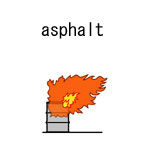| Case Name |
Fire of iron sulfide in an asphalt tank during a turnaround shutdown |
| Pictograph |

|
| Date |
October 15, 1992 |
| Place |
Kawasaki, Kanagawa, Japan |
| Location |
Refinery |
| Overview |
A fire occurred at an asphalt tank of an oil refinery. From October 5th, 1992, for an overhaul inspection of the asphalt tank, gas oil was injected, and it was circulated for three days. Gas oil was drawn off after 15:00 on October 14th, and the manholes were opened. White smoke was generated about 12 hours later, and there was a fire. Combustible iron sulfide was generated in the tank, generated heat, became a source of ignition, and residual gas oil burned. Having changed the tank-cleaning method before tank opening is considered one of the causes. |
| Incident |
A fire occurred at an asphalt tank in an oil refinery. A 2000 kL asphalt tank was washed with gas oil after transferring the contents for a turnaround shutdown. The gas oil used for washing was drawn off, and three manholes were opened and left. The mixture of light oil and asphalt that remained at the tank bottom ignited about 12 hours later, and there was a fire. |
| Processing |
Storage |
| Chemical Equation |
Fig2.Chemical reaction formula
|
| Substance |
Asphalt |
| Type of Accident |
Fire |
| Sequence |
On August 27th, 1992, a turnaround shutdown of an asphalt tank (a corn roof type, 2000 kL) started. Stored asphalt was transferred to another tank by September 18th.
Gas oil was injected and circulated in the tank for washing from October 5th for three days.
From 09:00 on August 12th to 15:00 on August 14th, gas oil in the tank was transferred to another tank. Three manholes were opened after transfer for ventilation.
No trouble was found at the patrol at 02:40 on August 15th.
About 03:40. Smoke came out from vents, manholes, and a flange of the tank.
03: 47. Self-defense fire fighters started foam fire extinguishing to the side wall manhole. However, the fire was only controlled temporarily. 2 or 3 m flames spurted out.
04:10. The public fire brigade started cooling by spraying water.
06:08. Water injection through the roof manhole and the ruptured opening started.
06:17. Public fire fighters confirmed the fire was extinguished. |
| Cause |
As a result of the reaction of iron at the roof and sidewalls inside the tank with oxygen, moisture, and hydrogen sulfide over many years, combustible iron sulfide was generated. It reacted with oxygen in the air that flowed in by opening the manhole, temperature rose, and ignited. It separated and fell from the inner wall. It was considered that the gas oil (about 1 kL) and asphalt that remained at the tank bottom ignited. Sludge acted a candle.
The reaction formula that generated the combustible iron sulfide is shown in Fig2. |
| Countermeasures |
Washing of residual asphalt by circulating gas oil was stopped. The washing method was returned to the former way, removal by chipping by hand.
The manhole for an old level gauge was removed including other tanks of the same structure. |
| Knowledge Comment |
At an overhaul of a tank, air contacts the place where usually air is not present.
If iron, hydrogen sulfide and moisture are present, iron sulfide will be generated. In this case, if it dries during opening, spontaneous ignition naturally takes place. |
| Background |
An insufficient study that did not take into consideration the existence of combustible iron sulfide was the main cause. Generation of combustible iron sulfide must be predicted if there are iron, hydrogen sulfide and moisture in the environment. Existence of hydrogen sulfide was found when corrosion in the tank was discovered.
It seems that the washing method should not be changed when considering the existence of iron sulfide. |
| Incidental Discussion |
This example is also a problem based on management of change. To reduce washing time and cost, the method was changed. It was a good plan, but there was insufficient study and the change failed. |
| Reason for Adding to DB |
Example of fire caused due to a change of working methods |
| Scenario |
| Primary Scenario
|
Insufficient Analysis or Research, Insufficient Practice, Lack of Imagination, Poor Value Perception, Poor Safety Awareness, Inadequate Risk Recognition, Non-Regular Action, Change, Change of Operation Procedure, Planning and Design, Poor Planning, Poor Design, Usage, Maintenance/Repair, Overhaul, Bad Event, Chemical Phenomenon, Burning, Secondary Damage, External Damage, Fire, Loss to Organization, Economic Loss, Tank Damaged
|
|
| Sources |
High Pressure Gas Safety Inst. of Japan, High-pressure gas protection overview, pp.232-233, (1994).
High Pressure Gas Safety Inst. of Japan, Storage tank, Fire in asphalt tank, Accident examples of Petroleum refinery and Petrochemical unit, p.94 (1995).
The Kawasaki City Dangerous objects safety research association. Case of accident that is useful at present. Examples of accidents at dangerous facilities. (with FTA), pp.227-229 (1997).
|
| Physical Damage |
Damage to facilities. Some mixed oil burned. |
| Financial Cost |
¥ 8 million. (Accident examples of Petroleum refinery and Petrochemical unit) |
| Field |
Chemicals and Plants
|
| Author |
ITAGAKI, Haruhiko (Japan National Institute of Occupational Safety and Health)
TAMURA, Masamitsu (Center for Risk Management and Safety Sciences, Yokohama National University)
|
|